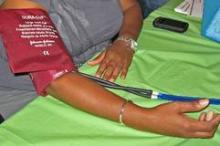Risk factors for cardiovascular disease have disproportionately affected women and blacks, and while the gender gap has narrowed over time, black-white disparities have widened, reported authors of a large 10-year cohort study published Aug. 11 in the journal Circulation.
The study showed that factors such as high cholesterol and smoking account for less cardiovascular disease (CVD) risk than in the past, said Dr. Susan Cheng of Harvard Medical School in Boston and her associates. "However, the combined contribution of all traditional risk factors has remained substantially higher in women, compared with men, and in blacks, compared with whites," the investigators said. "These sex- and race-based differences continue to be especially pronounced for hypertension and diabetes mellitus."
The researchers calculated the population-attributable risks (PARs) of five major modifiable risk factors – smoking, hypercholesterolemia, hypertension, diabetes, and obesity – for the 10-year incidence of CVD among 13,541 participants in the Atherosclerosis Risk in Communities (ARIC) study. The cohort was 56% female, 26% black, and aged 52-66 years when examined during the time periods 1987-1989, 1990-1992, or 1996-1998, the investigators said (Circulation 2014 Aug. 11 [doi:10.1161/circulationaha.113.008506]).
The contribution of smoking and high cholesterol to CVD risk fell, (from 0.15 to 0.13 and from 0.18 to 0.09, respectively) during the study period, and the contribution of obesity stayed the same at 0.06, the researchers reported.
But by 1996-1998, diabetes mellitus accounted for significantly more CVD risk in blacks than whites (0.28 vs. 0.13), and the same was true for hypertension (0.36 vs. 0.21; P = .08) and all risk factors combined (0.67 vs. 0.48; P = .002), the researchers said. Similarly, PARs for women surpassed those for men for diabetes (0.21 vs. 0.14; P less than .0001) and hypertension (0.32 vs. 0.19; P = .02), they reported.
The racial differences suggest that prevention efforts based on traditional risk factors have benefited whites more than blacks, the researchers added. However, most blacks in the study were from the ARIC study center located in Jackson, Miss., so the race-based findings might be specific to that area, they noted.
"The reasons for persistent sex differences in attributable CVD risks over time are not yet clear," said Dr. Cheng and associates. They added that sex-based differences could stem from clustering; underrecognition or undertreatment of risk factors in women; biological differences that are not yet understood; or nontraditional risk factors in men.
The National Heart, Lung, and Blood Institute funded the study. Dr. Cheng also received funding from the Ellison Foundation. The authors reported no conflicts of interest.

